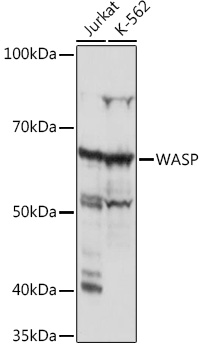Cell Biology Antibodies 17
Anti-WASP Antibody (CAB5132)
- SKU:
- CAB5132
- Product Type:
- Antibody
- Reactivity:
- Human
- Reactivity:
- Mouse
- Reactivity:
- Rat
- Host Species:
- Rabbit
- Isotype:
- IgG
- Research Area:
- Cell Biology
Description
| Antibody Name: | Anti-WASP Antibody |
| Antibody SKU: | CAB5132 |
| Antibody Size: | 20uL, 50uL, 100uL |
| Application: | WB IF |
| Reactivity: | Human, Mouse, Rat |
| Host Species: | Rabbit |
| Immunogen: | A synthesized peptide derived from human WASP |
| Application: | WB IF |
| Recommended Dilution: | WB 1:500 - 1:2000 IF 1:50 - 1:200 |
| Reactivity: | Human, Mouse, Rat |
| Positive Samples: | Jurkat, K-562, Mouse liver |
| Immunogen: | A synthesized peptide derived from human WASP |
| Purification Method: | Affinity purification |
| Storage Buffer: | Store at -20'C. Avoid freeze / thaw cycles. Buffer: PBS with 0.02% sodium azide, 0.05% BSA, 50% glycerol, pH7.3. |
| Isotype: | IgG |
| Sequence: | Email for sequence |
| Gene ID: | 7454 |
| Uniprot: | P42768 |
| Cellular Location: | |
| Calculated MW: | 60kDa |
| Observed MW: | 60KDa |
| Synonyms: | IMD2, SCNX, THC, THC1, WASP, WASPA |
| Background: | The Wiskott-Aldrich syndrome (WAS) family of proteins share similar domain structure, and are involved in transduction of signals from receptors on the cell surface to the actin cytoskeleton. The presence of a number of different motifs suggests that they are regulated by a number of different stimuli, and interact with multiple proteins. Recent studies have demonstrated that these proteins, directly or indirectly, associate with the small GTPase, Cdc42, known to regulate formation of actin filaments, and the cytoskeletal organizing complex, Arp2/3. Wiskott-Aldrich syndrome is a rare, inherited, X-linked, recessive disease characterized by immune dysregulation and microthrombocytopenia, and is caused by mutations in the WAS gene. The WAS gene product is a cytoplasmic protein, expressed exclusively in hematopoietic cells, which show signalling and cytoskeletal abnormalities in WAS patients. A transcript variant arising as a result of alternative promoter usage, and containing a different 5' UTR sequence, has been described, however, its full-length nature is not known. [provided by RefSeq, Jul 2008] |
| UniProt Protein Function: | WASP: a member of the Wiskott-Aldrich syndrome (WAS) family of proteins. A cytoplasmic protein expressed exclusively in hematopoietic cells. Transduces signals from surface receptors to the actin cytoskeleton. Associates with the small GTPase, Cdc42, known to regulate formation of actin filaments, and the cytoskeletal organizing complex, Arp2/3. Mutated in Wiskott-Aldrich syndrome, a rare, inherited, X-linked, recessive disease characterized by immune dysregulation and microthrombocytopenia. |
| UniProt Protein Details: | Protein type:Motility/polarity/chemotaxis; Adaptor/scaffold Chromosomal Location of Human Ortholog: Xp11.4-p11.21 Cellular Component: intercellular junction; vesicle membrane; cytosol; actin cytoskeleton Molecular Function:identical protein binding; protein binding; phospholipase binding; actin binding; SH3 domain binding; protein kinase binding Biological Process: epidermis development; T cell activation; actin filament polymerization; regulation of catalytic activity; actin filament-based movement; actin polymerization and/or depolymerization; innate immune response; defense response; protein complex assembly; immune response; endosome transport; blood coagulation; T cell receptor signaling pathway Disease: Thrombocytopenia 1; Neutropenia, Severe Congenital, X-linked |
| NCBI Summary: | The Wiskott-Aldrich syndrome (WAS) family of proteins share similar domain structure, and are involved in transduction of signals from receptors on the cell surface to the actin cytoskeleton. The presence of a number of different motifs suggests that they are regulated by a number of different stimuli, and interact with multiple proteins. Recent studies have demonstrated that these proteins, directly or indirectly, associate with the small GTPase, Cdc42, known to regulate formation of actin filaments, and the cytoskeletal organizing complex, Arp2/3. Wiskott-Aldrich syndrome is a rare, inherited, X-linked, recessive disease characterized by immune dysregulation and microthrombocytopenia, and is caused by mutations in the WAS gene. The WAS gene product is a cytoplasmic protein, expressed exclusively in hematopoietic cells, which show signalling and cytoskeletal abnormalities in WAS patients. A transcript variant arising as a result of alternative promoter usage, and containing a different 5' UTR sequence, has been described, however, its full-length nature is not known. [provided by RefSeq, Jul 2008] |
| UniProt Code: | P42768 |
| NCBI GenInfo Identifier: | 1722836 |
| NCBI Gene ID: | 7454 |
| NCBI Accession: | P42768.4 |
| UniProt Secondary Accession: | P42768,Q9BU11, Q9UNJ9, |
| UniProt Related Accession: | P42768 |
| Molecular Weight: | 502 |
| NCBI Full Name: | Wiskott-Aldrich syndrome protein |
| NCBI Synonym Full Names: | Wiskott-Aldrich syndrome |
| NCBI Official Symbol: | WAS |
| NCBI Official Synonym Symbols: | THC; IMD2; SCNX; THC1; WASP |
| NCBI Protein Information: | wiskott-Aldrich syndrome protein; eczema-thrombocytopenia; thrombocytopenia 1 (X-linked) |
| UniProt Protein Name: | Wiskott-Aldrich syndrome protein |
| Protein Family: | Waspkinin |
| UniProt Gene Name: | WAS |
| UniProt Entry Name: | WASP_HUMAN |







